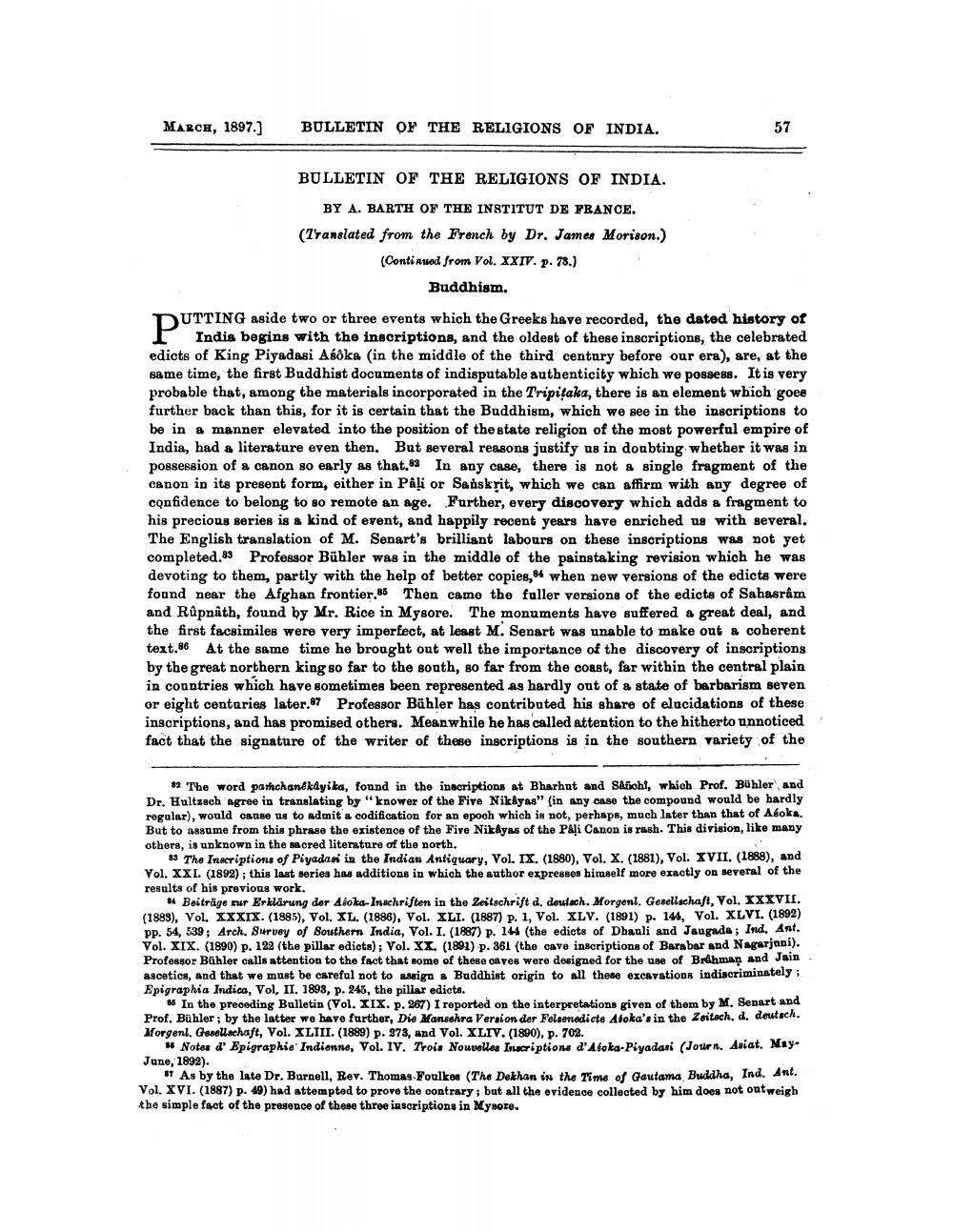________________
MARCH, 1897.)
BULLETIN OF THE RELIGIONS OF INDIA.
57
BULLETIN OF THE RELIGIONS OF INDIA.
BY A. BARTH OF THE INSTITUT DE FRANCE. (7Yanslated from the French by Dr. James Morison.)
(Continued from Vol. XXIV. p. 73.)
Buddhism.
DUTTING aside two or three events which the Greeks have recorded, the dated history of
r Indis begins with the inscriptions, and the oldest of these inscriptions, the celebrated edicts of King Piyadasi Asôka (in the middle of the third century before our era), are, at the same time, the first Buddhist documents of indisputable authenticity which we possess. It is very probable that, among the materials incorporated in the Tripitaka, there is an element which goee further back than this, for it is certain that the Buddhism, which we see in the inscriptions to be in a manner elevated into the position of the state religion of the most powerful empire of India, had a literature even then. But several reasons justify us in doubting whether it was in possession of a canon so early as that.82 In any case, there is not a single fragment of the canon in its present form, either in Pâți or Sanskrit, which we can affirm with any degree of confidence to belong to so remote an age. Further, every discovery which adds a fragment to his precious series is a kind of event, and happily recent years have enriched us with several The English translation of M. Senart's brilliant labours on these inscriptions was not yet completed.83 Professor Bühler was in the middle of the painstaking revision which he was devoting to them, partly with the help of better copies,84 when new versions of the edicts were found near the Afghan frontier,86 Then came the fuller versions of the edicts of Sahasrâm and Rûpnåth, found by Mr. Rice in Mysore. The monuments have suffered a great deal, and the first facsimiles were very imperfect, at least M. Senart was unable to make out & coherent text.86 At the same time he brought out well the importance of the discovery of inscriptions by the great northern king so far to the south, so far from the coast, far within the central plain in countries which have sometimes been represented as hardly out of a state of barbarism seven or eight centaries later.97 Professor Bühler has contributed his share of elucidations of these inscriptions, and has promised others. Meanwhile he has called attention to the hitherto unnoticed fact that the signature of the writer of these inscriptions is in the southern variety of the
#2 The word parchandkdyika, found in the inscriptions at Bharhut and Sabioht, which Prof, Bühler and Dr. Hultzsch agree in translating by "knower of the Five Nikayas" (in any onse the compound would be hardly regalar), would cause us to admit a codification for an epooh which is not, perhaps, much later than that of Aboka. But to assume from this phrase the existence of the Five Nikayas of the PAļi Canon is rash. This division, like many others, is unknown in the sacred literature of the north.
$ The Inscriptions of Piyadasi in the Indian Antiquary, Vol. IX. (1880), Vol. X. (1881), Vol. XVII. (1888), and Vol. XXI. (1892); this last series has additions in which the author expresses himself more exactly on several of the results of his previous work.
* Beiträge nur Erklärung der Aboka-Inschriften in the Zeitschrift d. deulach. Morgenl. Gesellschaft, Vol. XXXVII. (1889), Vol. XXXIX. (1885), Vol. XL. (1886), Vol. XLI. (1887) p. 1, Vol. XLV. (1891) p. 144, Vol. XLVI. (1892) pp. 54, 539; Arch. Survey of Southern India, Vol. I. (1887) p. 144 (the edicts of Dhauli and Jeugada; Ind. Ant. Vol. XIX. (1890) p. 122 (the pillar edicts), Vol. XX. (1891) p. 361 (the cave inscriptions of Barabar and Nagarjani). Professor Bühler calls attention to the fact that some of these caves were designed for the use of Brahman and Jain ascetics, and that we must be careful not to assign a Buddhist origin to all these excavations indiscriminately i Epigraphia Indica, Vol. II. 1893, p. 245, the pillar edicts.
85 In the preceding Bulletin (Vol. XIX. p. 267) I reported on the interpretations given of them by M. Senart and Prof, Bühler ; by the latter we have further, Die Mansehra Version der Felsenedicte Aloka's in the Zeitsch, d. doutach. Morgenl. Gesellschaft, Vol. XLIII. (1889) p. 273, and Vol. XLIV. (1890), p. 702.
* Notes d' Epigraphie Indienne, Vol. IV. Trois Nouvelles Incriptions d'Aloka-Piyadasi (Journ. Asiat. Naye June, 1892).
11 As by the late Dr. Burnell, Rev. Thomas Foulkes (The Dekhan in the Time of Gautama Buddha, Ind. Ant. Vol. XVI. (1887) p. 49) had attempted to prove the contrary; but all the evidence collected by him does not outweigh the simple fact of the presence of these three inscriptions in Mysore.




